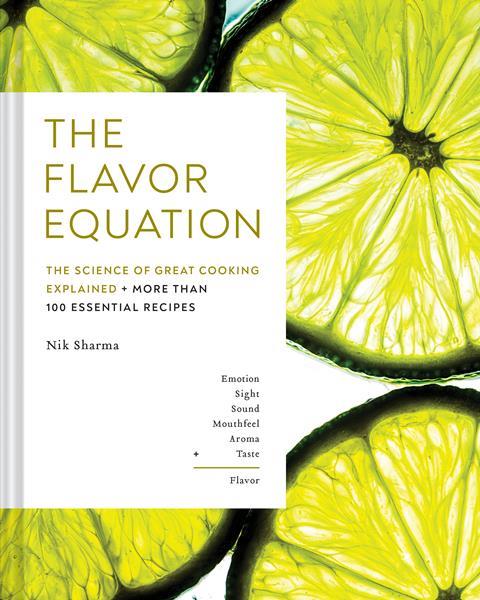Nik Sharma
Chronicle Books
2020 | 352pp | £26
ISBN 9781452182698

Buy this book on Amazon.co.uk
Buy this book on Bookshop.org
The molecular gastronomy revolution of the 2000s was a huge win for chemistry and its relationship with the public – it made our science relatable, accessible and relevant like few other things could, and it showed that science and art are not mutually exclusive. I think a strong understanding of this is also key to a good food science book. Although it has its highlights, The Flavor Equation doesn’t really get it right. Ultimately, it feels like the reluctant love child of a bizarre school science textbook and an excellent recipe book.
Nik Sharma is a food journalist based in California. He has an award winning blog, A Brown Table, and is a contributor to the popular Serious Eats website. Like his colleague at Serious Eats, J Kenji López-Alt, Sharma has a science background (as a molecular biologist) before turning to cookery.
However, while López-Alt’s book The Food Lab – which I also reviewed – was bursting with deep dive analyses of ingredients and recipes, helping you to understand your favourite foods at a fundamental level, the science in The Flavor Equation mostly feels like a collection of (sometimes random) facts that aren’t relevant or applicable. Although the intro section is particularly guilty of this – the biology of our ears might be interesting, but does it help you make better food‽ – the rest of the book hardly fares any better. For example, the Brightness chapter goes to great lengths to explain acidity and alkalinity, but doesn’t say more about the role of lye in making ramen beyond the fact that it is affecting gluten formation. As a home cook, I’m far more interested in understanding the latter than knowing how to calculate pH values.
There was so much of this throughout the book that I began to wonder if I was being obtuse and missing obvious ways to apply the science. However, even my biologist partner struggled to see the relevance of much of the content.
By the time I was ready to try a recipe, I was feeling pretty cynical. But luckily, I was pleasantly surprised. Sharma’s Indo-Chinese and fusion creations are genuinely exciting, and the recipes are well written and easy to follow. The book even provides metric equivalents to unfathomable US measurements (please stop measuring irregular solids by volume). The Goan shrimp, olive and tomato pulao from the Savouriness chapter packs an impressive umami punch and the spareribs in malt vinegar from the Brightness chapter really made me think about the balance of acidity with the fat, sweetness and chilli heat in the dish.
While these recipes give practical and delicious showcases of each featured flavour component, they’re not enough to connect you with the science, especially if you’re new to food science. And if you’re a more experienced cook, you won’t really learn too much here that you don’t already know from received wisdom of traditional cookery.
Science and art are perhaps not mutually exclusive, but getting them to work together is not a straightforward task. If you’re a confident cook and you’re a fan of Sharma and his style of food, you are likely to enjoy the recipes and the beautiful photographs. But if you’re looking for an introduction to food science or you want to expand your knowledge base, I’d suggest looking elsewhere.












No comments yet